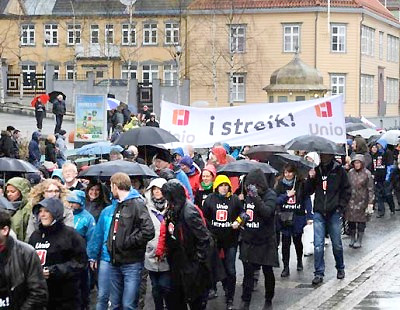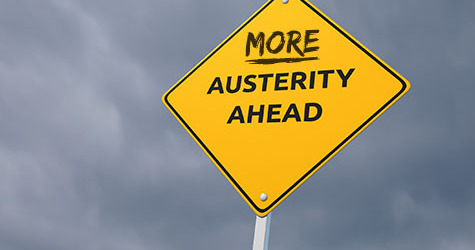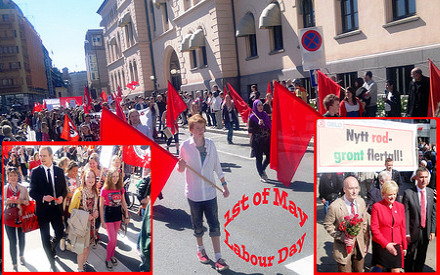Europe’s Most Leftist Government Defeated by Right-Wing Coalition
The red-green coalition government in Norway, whose political platform when it took power in 2005 was called the most progressive in Europe, experienced a bitter defeat in the country’s parliamentary election on 9 September. A coalition of four centre-right and right-wing parties, including a right-wing populist party, gained a solid majority and are now negotiating the political platform for a new government.
This happened in a situation in which oil revenue is pouring into the public coffers, the economic crisis goes virtually unnoticed, the unemployment rate is at a record low, real wages have been steadily increasing for a long time and most of the welfare state is still intact. To put it short, the country, with its abundance of oil and natural gas resources, and a history of democracy and social equality, represents a lucky exception in the world. How on earth could a red-green government at all lose an election in such circumstances?
What Happened?
| Seats won (change) | 2013-Election Results (%) | Change from 2009 (%) | |
|---|---|---|---|
| Left Coalition | |||
| Labour Party | 55 (-9) | 30.8 | -4.5 |
| Socialist Left Party | 7 (-4) | 4.1 | -2.1 |
| Centre Party | 10 (-1) | 5.5 | -0.7 |
| ** Total ** | 72 (-14) | ||
| Right Coalition | |||
| Progress Party | 29 (-12) | 16.3 | -6.6 |
| Conservative Party | 48 (+18) | 26.8 | +9.6 |
| Liberal Party | 9 (+7) | 5.2 | +1.4 |
| Christian Democrats | 10 (0) | 5.6 | 0 |
| ** Total ** | 96 (+13) | ||
| (for complete results, see wikipedia.org) | |||
Let us first recall what happened. The defeated government consisted of three political parties (percentage gained at the recent election and change since 2009 in parenthesis): the Labour Party (30.8, -4.5), the Socialist Left Party (4.1, -2.1) and the Centre Party (mainly a peasant or rural party) (5.5, -0.7). This majority government came to power in 2005 and was re-elected in 2009. The opposition has been made up of (from right to centre) the Progress Party (16.3, -6.6), the Conservative Party (26.8, +9.6), the Liberal Party (5.2, +1.4) and the Christian Democrats (5.6, -0.0).
The successful winner of the election was thus the Conservative Party, which had tactically softened its rhetoric, particularly toward the trade union movement, in the same way as the Swedish Conservatives so successfully had done it in their previous elections, though without softening its political practice after the successful elections. The situation in the Norwegian parliament is now as follows: the four centre-right parties have 96 MPs, the red-green alliance 72 while a newcomer, the Green Party, gained one. The Red Party did not succeed in winning any seats.
There are strong contradictions inside the centre-right coalition – particularly between the Progress Party on the one hand and the Christian Democrats and the Liberal Party on the other. However, all the four parties had guaranteed that an electoral victory should result in a new right-wing government, so this will surely happen.
The Background
It is important to know the background for the current red-green government in order to understand what happened in this year’s election. We have to go back to 2000/01 when the Labour Party, already with Jens Stoltenberg as Prime Minister, led a minority government. This government carried out an extensive programme of privatization and deregulation – and other types of Third Way, Tony Blair inspired policies, which made the government extremely unpopular among its traditional voters. The result was a catastrophic election in 2001 in which the Labour Party gained only 24 per cent of the vote, the lowest in any parliamentary election since 1924, and which produced a centre-right government.
This situation gave large parts of the trade union movement and other progressive forces an opportunity to intervene. A broad coalition of social forces was formed, and particularly the trade union movement, under pressure from many of its local branches, took a more active and progressive political role. In short, these forces pushed the Labour Party to the left and, for the first time in its history, into a coalition with the Socialist Left Party and the Centre Party. Under pressure from the same forces, all three parties campaigned on an anti-privatization platform in 2005, won the election, and formed a government based on the most progressive political platform in Europe (although the competition is not very hard).
We can identify four main elements which contributed to this success:
- Focus on alternative analyses – a system critical view of current developments.
- The building of new, broad and untraditional alliances.
- The development of concrete alternatives to privatization and marketization.
- Trade unions developing into more independent political actors.
Among other things, the Norwegian Confederation of Trade Unions (LO), for the first time in its history, urged people to vote for “one of the red-green parties,” not only the Labour Party as had previously been the rule. These developments contributed to polarizing the election campaign between the Right and the Left, something which gave people clearer political alternatives and helped to mobilize for progressive change.
The 2005 red-green government started off by carrying through a number of progressive policies. However, as time went by, and the pressure from the movement declined, the government began to slide back to mainstream political positions as opposed to the New course which was promised. Even if great parts of the trade union movement politically had become more independent from the Labour Party, other parts were still too loyal to oppose and to keep up the pressure when welfare provisions were weakened or market-oriented by ‘their own’ government. The trade union movement failed, in other words, to tackle the change from opposition to a position of challenging the Labour Party. This failure to keep up the pressure on the Labour Party contributed most probably to the current election defeat for the red-green government and thus made the trade union movement jointly responsible for it.
The Roots of the Discontent
So why did more and more of the red-green voters become discontent with ‘their own’ government? It was not mainly about wages, income or ordinary people’s material living conditions (except for rocketing house prices, which make it more and more difficult for young people to enter the housing market). It was first and foremost related to the development of the labour marked (not all of it, there is obviously a polarization going on). Those who toil and moil the hardest did not feel that they were represented by anyone in the red-green alliance. Quite the opposite, although under pressure from the trade union movement, the government did introduce some important measures against social dumping.

Restructuring of the public sector in the form of New Public Management-inspired policies has been met with increasing frustration and discontent – particularly an extremely unpopular hospital reform. A culture of distrust has emerged – not least as a result of the management to target model which has brought with it increased control from above, more and more detailed reporting, centralization of power while responsibility is being decentralized, less influence and control over one’s own work and increased demands for loyalty to the management.
In large parts of both private and public sector increased competition, fragmentation of companies, outsourcing and growing elements of more aggressive financial investors have contributed to increasing work intensity to a level almost unbearable to many workers. This tendency is particularly strong where trade unions are weak, or where employers through outsourcing, competitive tendering and the increased use of temporary workers have been able not only to weaken, but even get rid of trade unions. This increased brutalization of work creates a sense of powerlessness, resignation and a feeling of being worthless. The resulting aggressions and discontent will of course also be targeted toward the politicians in power – with good reasons.
Finally, the workfare policy which is directed toward those who are in the weakest position in the labour market is not being felt as help and support from a generous welfare state, but as repressive and disciplinary punishment. Important parts of the workfare ideology restore much of the bourgeois moralism from the end of the 19th century, in which social problems, unemployment and exclusion from the labour market are changed from being considered a social to once again being seen as an individual problem – where the individual’s work ethic is the main problem.
The red-green government did also become increasingly vague about its policies on privatization, and did in fact itself promote an extensive commercialization of nursery schools. A comprehensive pension reform weakened and individualized the pension system as it excluded some low-wage groups from an early retirement scheme and also reduced future pensions for younger people. In both fisheries and agriculture the government pursued policies which contributed to introducing capitalist ownership in these industries which in the past had been strongly regulated and collectively organized through the association of producers.
Different from most previous election campaigns, the red-green government this time did not even come up with a single new progressive reform for which its supporters could mobilize and which could create the needed support and enthusiasm for a new victory. “The right-wing political alternative is worse” became the extremely defensive slogan for many in the trade union movement. Add to this the fact that the red-green government also had involved itself in imperialist wars (Afghanistan, Libya) and had increased its cooperation with the International Monetary Fund and the Word Bank, which the government stated in its declaration of 2005 it would rather reduce, and we see a pretty clear pattern of a government which has step by step moved away from its progressive platform and slid gradually toward more and more mainstream and soft neoliberal positions. This is the reason why it lost the election, and it is difficult to explain it in any other way than that the red-green government fell in its own trap.
The Character of the Progress Party
Many commentators outside Norway have expressed their surprise that the former political party of terrorist Anders Behring Breivik (ABB), the Progress Party, now will become part of the new government, only two years after Breivik’s mass murders of 69 young social democrats. ABB was a member of the youth organization of the Progress Party many years ago, but in Norway this party has not been blamed for his ideas or his terror actions. The extreme ideas and ideology he expressed in his manifesto, and indeed through his horrible acts, were developed in contact with other networks and individuals after he left the Progress Party, which he criticized for being too liberal.
The Norwegian Progress Party is a typical right-wing populist party, but compared to many others of the same sort, it is seen as a more moderate version, although this is being contested. It is economically neoliberal and anti trade union. The party has through its history on the one hand excluded some members, who have expressed openly racist views, but on the other hand, it has always more or less indirectly pandered to the xenophobic parts of the electorate during election campaigns, and it is harbouring some extreme anti-immigrant members. It shares many features with the Danish People’s Party and pushes many of the same policies as the Sweden Democrats, even though the Progress Party itself does not consider these two parties as its sister organizations.
In any case, if the Progress Party now succeeds in becoming part of the new right-wing government of Norway, it will represent a political breakthrough for this kind of right-wing populist parties, which will most probably also be used as a marketing asset for similar parties in other countries.
A Protest Election
Nothing suggests that there is a growing demand for more right-wing policies in Norway. The election result is rather an expression of frustration, discontent and protest against the current government. Political changes, however, are seldom logically rational. The right-wing populist party (the Progress Party) has always been clever at exploiting discontent like this. In this year’s election also the Conservative Party manoeuvred so as to cash in on the discontent with the red-green alliance. It scaled down its own political rhetoric and rather tried to stand forth as a secure and compassionate alternative to the red-greens – concerned with people’s daily problems.
The reality will of course be different. In most areas where people are discontent with the red-greens, the new right-wing government will be even worse. There will be more privatization and commercialization of welfare services, more attacks on collective agreements and labour legislation and cuts in public budgets to finance their tax cuts. State ownership will be reduced and foreign capital will most probably increase its ownership in important sectors of the economy. Furthermore, we can also expect more aggressive and self-confident employers and employers’ associations.
Given the exceptionally favourable socio-political backdrop in Norway, with its abundance of oil revenue and a safe parliamentary majority, it is easy to believe that the election defeat could have been avoided by the red-green government – not first and foremost by spreading more oil money on all worthy causes, but by democratizing the public sector rather than marketizing it, by regulating financial markets after the financial crisis rather than only saving the banks, by increasing taxes on the rich rather than keeping public budgets overly tight, by introducing a social housing policy, etc. This, however, does not seem to be the preferred policy of the dominant Labour Party, and the Socialist Left Party has not been able to change this political direction.
In this regard, the development in Norway follows the pattern we have seen in country after country in Europe where political parties to the left of the social democrats have joined them in government. All such experiences, without exceptions, have been anything from negative to disastrous – in France, in Italy, in Norway and it is now happening even faster in Denmark – and the most left-oriented political party in such coalitions loses the most.
To join a social democratic dominated government as a junior partner in a situation in which the social democratic parties have moved far to the right, where financial markets are deregulated and where neoliberalism is constitutionalized as the economic model of Europe (or at least of the EU, Norway is formally outside, but part of the single market), is obviously a dead end. What surprises us is that none of the left parties in Europe seems to analyse and learn from this. It seems as if Die Linke in Germany, the Socialistische Partij in the Netherlands and Vänsterpartiet in Sweden are all aiming at becoming accepted into a social democratic dominated government in their countries.
In Norway, we have to take up again the work we did before the 2005 election, to build broad social alliances, to develop a system critical minimum programme, to fight for a more politically independent, progressive trade union movement, which can take a broader social and political responsibility and put the political parties in the labour movement under increased pressure. We need real social mobilization for real changes. •





